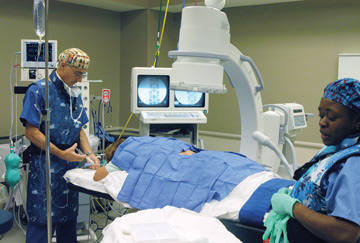In the absence of antibiotic alternatives, physicians in the early 1900s had no choice but to treat every infection with penicillin. Chronic pain went through a similar "penicillin phase." No matter the type of back pain — radicular, axial or arthritic — patients got an epidural steroid injection (and perhaps a recurring script for opioid painkillers). But with the advent of treatments like radiofrequency ablation and spinal cord stimulators, pain management is shedding its penicillin phase.
"Pain management is just starting to come out of that one-size-fits-all approach to treating patients," says neurologist Vladimir N. Kramskiy, MD, the director of the Ambulatory Recuperative Pain Medicine Program at the Hospital for Special Surgery in New York City.
With facilities pressed to find opioid-free ways to manage chronic pain, the timing of these promising interventions couldn't be better.
1. Epidural steroid injections. Steroid injections in the epidural space around the spinal cord to reduce the inflammation of a problematic nerve root remains chronic pain medicine's bread-and-butter procedure. It's quick and effective (for the right patients). Roughly half of the 5,000 injections administered each year at the Montefiore Multidisciplinary Pain Program are epidurals, says Naum Shaparin, MD, the program's director at the Montefiore Medical Center in the Bronx, N.Y.
"Even in an academic environment, we could still do 14 to 16 injections per day, per room," says Dr. Shaparin. "In a private practice environment, you can double or triple that amount."
Who's best suited for epidural steroid injections? "People with clear radicular pain respond best," says Steven P. Cohen, MD, chief of pain medicine at Johns Hopkins Medicine in Baltimore, Md. "A herniated disc responds better than spinal stenosis, but spinal stenosis responds, too."
Epidurals are less effective for longtime opioid users who've had many failed procedures, including back surgery, adds Dr. Cohen, who also serves as the director of pain research at Walter Reed National Military Center in Bethesda, Md.
For the most part, steroid injections are cost-effective. The supplies are minimal, and for an ASC, the facility fee is around $400 depending on your location, says Dr. Cohen. But the problem is the relief is temporary — on average, the injections last 3 to 6 months — and highly variable.
2. Radiofrequency ablation. A more involved, albeit costly, intervention is the thermal ablation of the nerve. Radiofrequency ablation is a multi-step procedure for chronic pain treatment that uses an electrical current produced by a radio wave to burn an area of the nerve that causes pain and thus decrease the pain signals coming from that area. The first step is a medial branch block, an injection to determine if the medial branch nerves surrounding the facet joints — small joints between the vertebrae at the back of the spine — are the source of the patient's pain.
.svg?sfvrsn=be606e78_3)

.svg?sfvrsn=56b2f850_5)